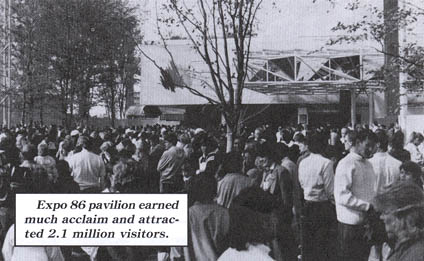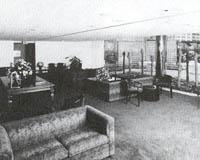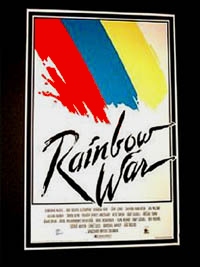Vol. 17 No. 7
July, 1987
|
Stay Safe in 87
|
|
"It Was a Career
Highlight" Says Two-Time Expo Staffer

Montreal - The recent reunion of Canadian Pacific's Expo 67 pavilion staff held a
special meaning for Jacques Giguere.
Mr. Giguere has the distinction of being the only Canadian Pacific employee on staff at the company's pavilions at
both Expo 67 in Montreal and Expo 86 in Vancouver.
At the 1967 exposition, Mr. Giguere was operations manager; at Expo 86 last summer he was assistant director general
of the pavilion, a position he will continue to hold until the end of this year.
"We had one of the best pavilions at Expo 67 and we had the best pavilion at Expo 86", Mr. Giguere said
with no small measure of pride. "Working at an Expo has got to be the highlight of anyone's career, no matter
who you are. And the opportunity to work on two (Expos) can't be described.
"Our success at both exhibitions", he added "in fact, the success of any project, was due to the
teamwork of everyone involved. I cannot emphasize this enough".
At Expo 86, Canadian Pacific's pavilion was open 12 hours a day, seven days a week, for a period of 165 days. Thirty
presentations to the public were made each day, with large groups of visitors being brought into the pavilion every
24 minutes.
The 92 people on staff, 17 of whom were loaned employees from various Canadian Pacific entities, worked tirelessly
throughout the summer to accommodate a total 2.1 million visitors to the pavilion, Mr. Giguere said.
The project took three and a half years of preparation prior to opening day 2 May 1986. The goal of the
working committee responsible for the project was to develop a pavilion which was informative, entertaining, and
amusing.
A well-designed traffic flow was developed to permit large numbers of guests to visit the pavilion
safely and comfortably.
Just prior to Expo, selected guides and hostesses underwent an intensive, one-month training program
which covered a variety of subjects, including first aid, proper grooming, and protocol. The training included many
simulated exercises.
The 25,000-square-metre pavilion was distinctly Canadian Pacific.
All of the structural steel originated from Algoma Steel. The interior decoration of the Van Horne Room, used for
guest entertainment and special functions, was done by Corporate Premises.
| |

Van Horne Room Expo 86 Pavilion.
|
The displays in the Van Horne Room were significant to CP Rail's involvement with the West and with Vancouver. Its
lounge garden featured a CPR-embossed Tyndall stone from the dismantled station at Fort William (now
Thunder Bay). The ship's bell from the "MV Van Horne" was mounted and served as a means of getting
guests' attention and making announcements.
Computer and Communications exhibited their equipment and services in the pavilion's offices.
A special china service was struck for the pavilion featuring the corporate colors of blue and white and the pavilion
colour "splotch". The service drew the attention of invited guests to Syracuse China, a Canadian Pacific
subsidiary.
Catering for invited guests and for special functions was handled by the airline catering operations of CP Hotels.
Special bottlings of British Colombia wines were provided with unique, specially-printed labels.
The pre-show area of the pavilion was designed to handle groups of up to 525 people at a time. There,
the guests watched a video shown simultaneously on five television screens. The video relied heavily on humor to
achieve its entertainment goal and, at the same time, introduced visitors to Canadian Pacific and its many entities.

Expo 86 Pavilion Time Wall exhibit.
From there, the visitors were taken to the pavilion's "Time Wall" exhibit, a multi-media
presentation of 20 set pieces each containing a three-dimensional scene and a mannequin or mannequins
with television sets for heads.
At the center of the wall was the host, Father Time, consisting of four television sets - one for each eye, one for
the nose, and one for the mouth. Special effects included animatronics, artificial smoke, moving background scenery,
characters switching heads, neon lighting, and sound effects.
The storyline pointed out that not withstanding the great advances in the technology of transportation and
communication in the last 100 years, people still have to face up to problems inherent in each mode of
transportation and also learn to communicate with each other.
| |

Rainbow War poster.
|
At the end of the presentation, Father Time directed the crowds to a second theatre for the screening of the Academy
Award nominated film "Rainbow War". The film is an adventure/fantasy which describes how people of
different cultures deal with the problems created by advances in transportation and communications technology and how
their lives are enriched as they learn to understand and live with each other and work together.
In a report on the company's participation, Fred Joplin, Commissioner and Director General of the Canadian Pacific
Pavilion wrote:
"Even those who in the past have taken the most biased view of our corporate activities, found themselves in the
unusual position of giving favorable comment on the pavilion, the staff, and the presentation".
"The press, TV, and radio, were, without exception, most favorable in their comments. MacLean's Magazine gave
only two 10s in its assessment of Expo's many activities; these went to the fireworks and the Canadian Pacific
Pavilion".
This CP Rail News article is copyright
1987 by the Canadian Pacific Railway and is reprinted here with
their permission. All photographs, logos, and trademarks are the property of the Canadian Pacific Railway
Company.
|